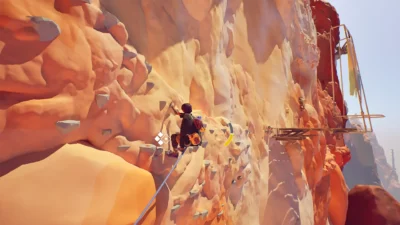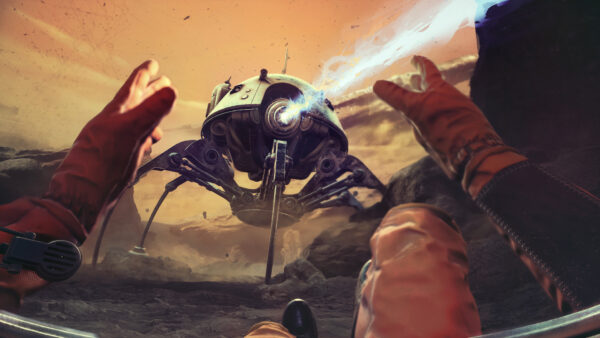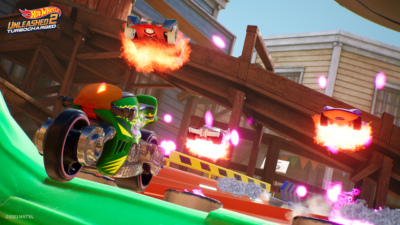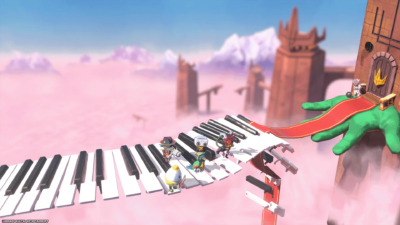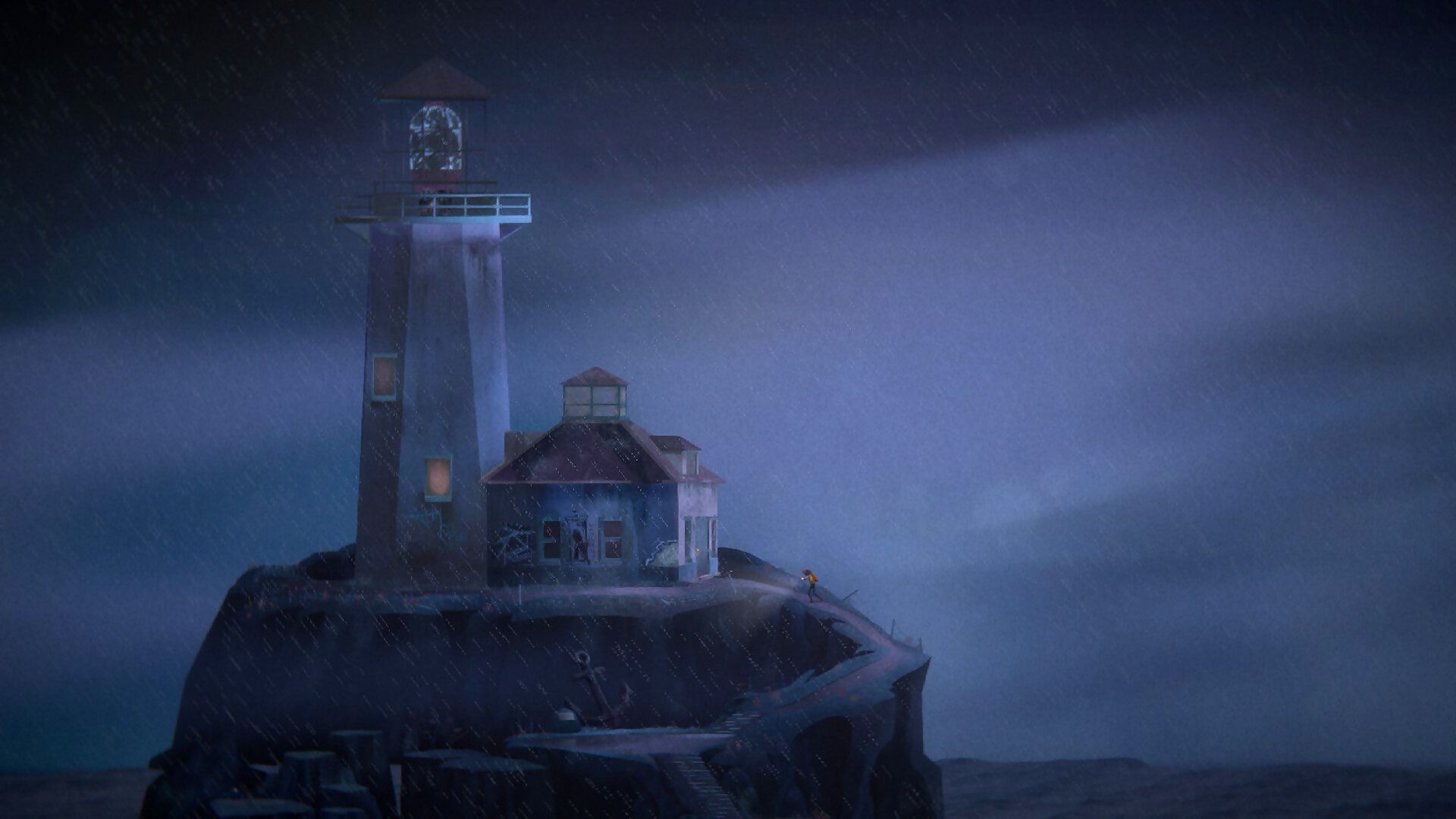
Oxenfree II builds on the foundations of the 2016 original, leading us to a world both familiar and very different. It’s the same atmosphere – the same vibe – there’s plenty of supernatural goings-on, you’ll be chatting a lot (with wonderfully written dialogue), and the story itself picks up not too long after the events of the first game. This time around, players take on the role of new protagonist Riley, a 30-something who grew up in Oxenfree II’s setting, the town of Camena, before leaving to find her way in life. She’s back for a job, returning to her roots and forced to confront not just the giant portal looming over the town, but also her past. Her life. Her hang-ups. Small-town ambience anyone from that sort of place knows well.
It’s a fine thread to weave, mixing a near-universal nostalgia with a coming-of-age tale featuring a cast largely aged 30-plus – and on top of that featuring a supernatural, existential threat. But there’s a confidence in the air around Oxenfree II, the sort of thing that comes when a team like Night School Studio builds off the back of an incredible success like the first game in the series.
If almost anyone else came up pitching the idea of a woman reconnecting with her roots, encountering old friends, and chatting with strangers on walkie-talkies mixed with time portals… well, you’d at least have a few questions to ask. Not with Oxenfree II. It sounds great. And, well, there are still some questions.
Bewitched by the sense of wonder and wishing to find out more about the mysteries within Oxenfree II, we sat down for a chat with Sean Krankel, studio director at Night School Studio, and Adam Hines, the studio’s lead writer.
The original game was something of an indie darling, everybody seems to know of it – does that make for pressure in creating a sequel?
SK: It definitely does. And not just because it ended up being received so well. But because we really just adore that story and didn’t want to return to it unless there was a reason to tell a new story in it. Which is why I think for us, it was important that we didn’t just do a continuation of the last one. I think that when we looked through what made Oxenfree special – now that we have had some distance from it – I think it’s mostly because it is a game that takes people that are going through a really important moment in their life, and it holds up a very strange, dark, surreal mirror to them, and forces them to reckon with a lot of coming-of-age events in a very short period of time in a very scary and surreal way. [Doing a sequel with new characters] let us tell a brand new story with a lot of the same rule set from the first game, but without making it feel like we were making a Scooby-Doo adventure with a bunch of characters going and doing the same stuff again. So, in short, yeah, I think the pressure comes partially because we want to live up to what the fans of the first game would want from one of these games. But also because we want to tell a story worth telling. We didn’t want to just put out Oxenfree II for the sake of doing it, and it took us a few years to find that story. But we’re really happy with where we’re headed.

The moon-worshipping cult, Parentage, has actually been patched in to the original Oxenfree in a wonderful example of how committed Night School is to consistency in its narrative.
You mentioned distance from the first game – how important has that been to the creation of the sequel?
SK: I think it’s been vital, honestly, because we can look at the game and we can see it a little more similarly to how people who just bought it for the first time could see it. After you ship a game, I think you’re so close to all of the flaws of it or the strange things that might stand out to you as being a little bit off, or you just notice all the individual parts. Sometimes it’s hard to see the forest because you’re looking at each tree. A few years going by helped us look at the game as a single experience, as opposed to a lot of different parts. Coming back to a world that is many onion layers of mystery that a player can unravel, and just trying to scare the shit out of people again, all that stuff feels really fun to do.
AH: It’s been nice to return to a game and play it now, and not just kind of see every perceived flaw and every little thing that we would have changed. When a piece of art [you’ve worked on] comes out, all you see is the stuff that you’d want to have more time to tinker with. But it’s great to see it now with fresh eyes, and see it as it is.
I mentioned pressure before, but at the same time, there has to be more confidence this time around. Is that true?
SK: I don’t know if we ever get a lot more confident… It’s like a medium-tier of confidence in the studio. Everybody is always really proud of their co-workers, and impressed by their ability and contributions. The general foundation of how we build our games is so much stronger than when we started; we didn’t have any of the toolset that could allow us to make this type of game. But I think the only additional confidence we had was that at least the rules of the game were already in our heads as we embarked on this one; we weren’t inventing a whole new set of supernatural rules and worlds. Other than that, it feels just as scary to me.
Oxenfree is a solid mix of heavy themes, sci-fi or creepy horror escapism, and a few bits of levity along the way – how important is a balance like that to a story like this?
AH: I don’t think we would ever want to do a game or tell a story that’s purely horror, or purely comedy. You have the drama, you have characters that really want to survive and want to get what they want in life, but they also have moments where you can scare the audience and make them laugh and make them cry and just have all the touches. All of our influences come from that kind of Spielbergian mix – a light touch of several different parts.
SK: With Oxenfree specifically, it is the most grounded game that we’ve made in the most grounded story; if ghost-y stuff wasn’t showing up, you’d just be some people walking around the Pacific Northwest talking about life and the challenges that life throws at you.
Oxenfree II focuses on a looming, ever-present threat over the lives of normal people. I might be going off the deep end here, but do you think the Covid era, the Covid paranoia, or whatever you might want to call it, has factored into the writing and the setting?
AH: I feel like there’s an answer: yes. Even if it’s in a subconscious way, we’ve made the entirety of Oxenfree II without being in the same room. Working from home, the experience is such a 180-degree turn from [working in the office together], it’s been a lot of just reminding ourselves to check in and reminding ourselves to do as much social stuff as we can with each other away from work. But it’s been much more regimented. Of course, with everything else that’s going on in the world, with the political landscape and everything that’s been surrounding that while we’ve been stuck at home, I’m sure all of it has filtered into probably every single aspect of this game. Just making the characters [older] means that they have a much more adult perspective on things, like we do. So that too has changed the tone of the game. But definitely that paranoia in the air and the fear of the unknown, not exactly being able to totally map out what the rest of your day will be like, never mind the rest of your weekend, month, and year, has absolutely impacted what we think is scary about this setting. And it’s happening to these characters, too, definitely.

Chatting, navigating, exploring, discovering, and sometimes being a bit scared: what Oxenfree II is all about.
Mentioning the move to an adult cast, how much does that actually change things? What does such a move bring to the overall experience?
AH: The first game – in a good way – myopically focused on that particular point of their lives, along with the individual problems that they’re going through. And in that same way, Riley, not to spoil things, but she’s going through a major life event. We calibrated her view on what her life should be now, and she’s really trying to make sense [of things], correcting some past mistakes, and setting the groundwork for a more successful future for herself… Having that nostalgic air that Oxenfree had, but having them as adults in their mid-30s [with] some past behind them just allows us to touch on way more adult themes and adult topics, and just have them be in a much more mature place than [before], which of course colours every conversation and every interaction that you have.
SK: Putting the game in Camena – the hometown of the characters from the first game – and having this be Riley returning to her hometown and [her old high school friend] Jacob being somebody who never left the hometown, it affords us the opportunity to keep it small and personal and reflect on those small-town aspects that do feel like that there’s kind of a built-in nostalgia there. I don’t know that there would be a good Oxenfree game that, say, goes to Tokyo. Adventures with ghosts in Tokyo. I think this setting is so much of what makes the game work – not just being the mood that it induces or the art style, but also what it represents. What is a small town to a small group of people? We maintained a lot of the general feel and that warmth from the first game, but we’re not approaching it as a bunch of 16-year-olds now.
The Netflix question
Night School Studio recently announced it had been acquired by Netflix in the streaming giant’s first real move into the world of gaming. Oxenfree II is nothing to do with the deal, and questioning about the topic was off-limits. Anyway, we asked about the deal and this is what Krankel told us: “Right now, it just means that we are able to keep doing what we do without the risk of – and fear of – going under, like every studio feels. It’s been extraordinary for us finding this partnership with Netflix, because they look to us to just keep expanding on the types of stories and game experiences that we’ve built, and afford us the opportunity to experiment even more than we have. Anybody who’s in any kind of smaller studio knows it’s hard to really experiment and try new things and take big swings over and over again. We’re going to have that opportunity now. It’s pretty exciting. Other than that, there’s no emphasis on what types of games we make, there’s nothing written in stone about anything other than just ‘Nice, cool, keep doing what you do’. And the Netflix team basically says, ‘We just want to supercharge you’. That’s it. It’s pretty exciting.”
‘Wonder’ is a word that you see bandied around for the original game, and I assume it’s here in the sequel. But how do you create ‘wonder’?
SK: That is an amazing… I think that’s maybe the best question of all time. ‘What is the meaning of life?’ ‘How do you create?’
Oh, that’s my next question…
AH: I can take a stab at it. It’s definitely every discipline working in sync and harmony. It definitely starts with the general visuals and wanting the characters to feel pretty small. And those environments and if you were to sit in on any of our scene reviews, it’s like, ‘Pull the camera back, pull the camera back’, because that became such a nice defining trait of Oxenfree. It was such a pillar of that feeling of wonder: I am just a speck in this world, trying to fight back against the current of the storm. Having those characters be in these very lush environments is one big aspect. [Our soundtrack] is another massive component of that, the score and the sound effects and the sound design and how all of that works in sync… It’s really every discipline trying to combine to make this one singular feeling that’s playing the game.

Rifts throughout Camena are a direct result of those darn teens from the original game.
How has the day-to-day production changed from the first game?
SK: Being remote sucks. We’ve made the most of it; I think we’ve fooled ourselves into thinking that we’re accustomed to it now and that it’s fine. But we actually had a couple of team get-togethers recently, and the electricity of when the team is back together is so different to speaking through Zoom. So I think the biggest change has been just adapting to remote work and trying to find ways to approximate in-person conversations and communication. This means there’s more documentation – I think in the first game we just overheard each other a lot, and that was how decisions got made; they were done in person. But now everything is getting documented all the time. There’s a lot more meetings that happen with a very clear intent, which I think is a big plus. With the first game, we meandered at times. But now the intentionality behind what a meeting looks like and how we all interact means that the output needs to be actionable. The other thing is that the team has gotten bigger. The core team of the first game was four, although we scaled up to about 15 by the end of the game. This one, I don’t even know at this point, probably 20-plus different people have touched the game in some way, shape, or form. The upside there is that you’re getting a lot more different fingerprints on the game to make it a more robust, yet diverse experience. The downside is that it’s just hard to translate [everyone’s] visions to each other.
Is there any advice you’d offer to other smaller indie teams?
SK: I think one of the few things we did really well out of the gate with the first game, that we continue to try to do, is just find one special piece of the game and focus all of our efforts on that, instead of trying to have 15 features and do them all to a mediocre tier. We knew our internal strengths when we started the studio related to storytelling, to how we could direct talent, to having a really strong visual style, and we just said ‘Let’s lean into those things’. We’re not going to do a server-side, multiplayer first-person shooter, or we’re not going to add a bunch of features just because they seem cool right now. We just wanted to do one thing and do it really well and be pretty unwavering with that. It’s more than enough work to just try and focus on doing one thing well. Just focus on doing one thing well and make sure it’s one special thing. Don’t try to come out and compete with everybody else, because the market is so overcrowded that you’ve got to have at least one thing that feels unique and special.

The ambience almost drips off the screen; there’s very much a sense of place with Oxenfree II.
So, what are your hopes for the game when it’s all done and out the door? Do you expect it to surpass the original?
SK: We don’t expect anything to surpass anything. We hope, we certainly hope. I think our expectations continue to shift over the years. With the first game, we just wanted it to come out and not have our whole studio collapse. I think our hope and expectation with this one is just that it resonates as strongly and gets as emotional a response from the audience as the first one did. We want you to be as embedded in this game and feel that degree of connection to the character in the event, and that it’s your version of Riley’s story, not anybody else’s. And so the game’s really been designed that way, to try to make it feel like everybody’s ending and the journey along the way feels crafted to what their choices were.
Creatively, we just want to evoke a lot of the same emotions, but through a different lens this time. Also, we haven’t talked about any of the mysteries of the game, which we won’t today either, but there are so many things we haven’t revealed – weird mysteries that we just can’t wait to see if they seem as cool to the world as they do to us. So I think that would be the other thing. We just hope that people connect with it.


